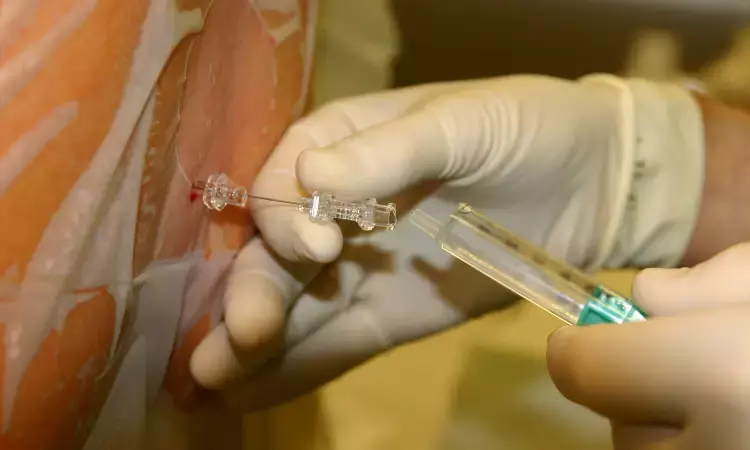- Home
- Medical news & Guidelines
- Anesthesiology
- Cardiology and CTVS
- Critical Care
- Dentistry
- Dermatology
- Diabetes and Endocrinology
- ENT
- Gastroenterology
- Medicine
- Nephrology
- Neurology
- Obstretics-Gynaecology
- Oncology
- Ophthalmology
- Orthopaedics
- Pediatrics-Neonatology
- Psychiatry
- Pulmonology
- Radiology
- Surgery
- Urology
- Laboratory Medicine
- Diet
- Nursing
- Paramedical
- Physiotherapy
- Health news
- Fact Check
- Bone Health Fact Check
- Brain Health Fact Check
- Cancer Related Fact Check
- Child Care Fact Check
- Dental and oral health fact check
- Diabetes and metabolic health fact check
- Diet and Nutrition Fact Check
- Eye and ENT Care Fact Check
- Fitness fact check
- Gut health fact check
- Heart health fact check
- Kidney health fact check
- Medical education fact check
- Men's health fact check
- Respiratory fact check
- Skin and hair care fact check
- Vaccine and Immunization fact check
- Women's health fact check
- AYUSH
- State News
- Andaman and Nicobar Islands
- Andhra Pradesh
- Arunachal Pradesh
- Assam
- Bihar
- Chandigarh
- Chattisgarh
- Dadra and Nagar Haveli
- Daman and Diu
- Delhi
- Goa
- Gujarat
- Haryana
- Himachal Pradesh
- Jammu & Kashmir
- Jharkhand
- Karnataka
- Kerala
- Ladakh
- Lakshadweep
- Madhya Pradesh
- Maharashtra
- Manipur
- Meghalaya
- Mizoram
- Nagaland
- Odisha
- Puducherry
- Punjab
- Rajasthan
- Sikkim
- Tamil Nadu
- Telangana
- Tripura
- Uttar Pradesh
- Uttrakhand
- West Bengal
- Medical Education
- Industry
Prediction of post-spinal anaesthetic hypotension using USG

Post-spinal anaesthesia Hypotension (PSH) is one of the most often encountered complications of spinal anaesthesia. Hypotension is caused by a reduction in systemic vascular resistance (SVR) as a result of sympatholysis and a decrease in cardiac output (CO) as a result of decreased venous return. The inferior vena cava collapsibility index (IVCCI) and carotid artery peak systolic velocity variation (CAPVV) have been widely researched as indicators of fluid responsiveness in a variety of patient groups, most notably critically sick patients. The major purpose was to determine the predictive value of IVCCI and CAPVV for PSH. Recently published research attempted to examine the prediction power of these two measures and to identify other predictors of PSH.
The study comprised 50 patients aged 18 to 65 years who had elective lower abdomen operations under spinal anaesthesia. Preoperatively, the IVCCI and CAPVV were determined using ultrasonography. After spinal anaesthetic was administered, haemodynamic data were gathered for 15 minutes. Our major goal was to determine the predictive value of IVCCI and CAPVV for PSH. The secondary aims were to examine the predictive effectiveness of these two variables and to identify other variables associated with PSH prediction. The receiver operator characteristic (ROC) curves for IVCCI and CAPVV were generated and the optimal cut-off values were determined. PSH was detected in 34% of patients. IVCCI >21.15 had a sensitivity of 58.8 percent and a specificity of 69.7 percent for predicting PSH. CAPVV >18.33 indicated PSH with a sensitivity of 70.6 percent and specificity of 54.6 percent, whereas IVC max/IVCCI >60 predicted PSH with a sensitivity of 58.8 percent and specificity of 54.5 percent. PSH may be predicted using a composite model consisting of IVCmax (maximum IVC diameter), CAPVV, and baseline mean blood pressure.
In adult patients receiving elective infra-umbilical surgery, neither IVCCI nor CAPVV was able to predict PSH. PSH may be predicted using IVCmax, CAPVV, and baseline MBP. While the fundamental mechanism of PSH is a pre-ganglionic sympathetic block induced by local anaesthetics, it is not explained by reduced pre- or after-load. PSH has a complex pathophysiology that involves the circulatory effects of local anaesthetics, relative adrenal insufficiency, skeletal muscle paralysis, ascending medullary vasomotor block, and concomitant respiratory insufficiency. That is presumably why the techniques that have been useful in predicting fluid responsiveness in other circumstances are ineffective for predicting Post-spinal anaesthesia Hypotension.
However, the findings of this study should be taken cautiously, and more research with bigger sample sizes is recommended, especially in older individuals and those with pre-existing cardiovascular disease.
Reference -
Chowdhury, Sumit R.; Baidya, Dalim K.; Maitra, Souvik; Singh, Akhil K.; Rewari, Vimi; Anand, Rahul K., Assessment of role of inferior vena cava collapsibility index and variations in carotid artery peak systolic velocity in prediction of post-spinal anaesthesia hypotension in spontaneously breathing patients: An observational study, Indian Journal of Anaesthesia: February 2022 - Volume 66 - Issue 2 - p 100-106
doi: 10.4103/ija.ija_828_21
MBBS, MD (Anaesthesiology), FNB (Cardiac Anaesthesiology)
Dr Monish Raut is a practicing Cardiac Anesthesiologist. He completed his MBBS at Government Medical College, Nagpur, and pursued his MD in Anesthesiology at BJ Medical College, Pune. Further specializing in Cardiac Anesthesiology, Dr Raut earned his FNB in Cardiac Anesthesiology from Sir Ganga Ram Hospital, Delhi.
Dr Kamal Kant Kohli-MBBS, DTCD- a chest specialist with more than 30 years of practice and a flair for writing clinical articles, Dr Kamal Kant Kohli joined Medical Dialogues as a Chief Editor of Medical News. Besides writing articles, as an editor, he proofreads and verifies all the medical content published on Medical Dialogues including those coming from journals, studies,medical conferences,guidelines etc. Email: drkohli@medicaldialogues.in. Contact no. 011-43720751


